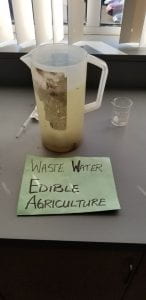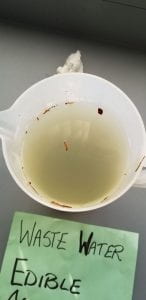Water Filter Challenge
Define:
We have been working on a group challenge in science class where we must filter waste water. We had to consider what others had done before us to filter water and how we could create our own filter. The main problem we had to solve during this project was to filter agricultural waste water from the farm Edible Agriculture so that it was clean enough to be released into the Pitt River. To make sure our filter would solve that problem, we did some research on other filters that had been made. Then we designed our own filter with the things we learned, and tested it to see if it would work. The materials we had access to for our filter included cheesecloth, carbon pieces, sand, filter paper, and cotton.
Discover:
Water filters function by allowing liquid to flow through something but still holding on to the solid pieces in it, therefore taking them out of the water. The water is slippery, so it slides through the filter, but big pieces of dirt get stuck in the filter. Sometimes during filtration, only the clean liquid is used and the solids that were taken out are discarded. Other times, the solid that was filtered out is also used. Filters can be made of many different mediums and types of equipment. There are different methods of filtration and some are as simple as a plastic pop bottle with sand inside, which is what we did for our own filter!
The problem of trying to clean dirty water has been addressed in many ways by people in the past. The earliest recorded information about water purification was in 2,000 BC. Some different ways water was purified in the past were boiling water over a fire, heating water using the sun, straining water through cloth, dipping hot iron into water, and using gravel, stones or seeds. Early humans would dig a deep hole in the sand close to a muddy river, and the sand would filter the water so that it was clear.
All these ways of water filtration have helped us to improve the design of the modern filters we have today. Common water filters in modern houses can be in different forms. Some examples are filters inside water pitchers, sink faucet filters, refrigerator filters, and filters under the sink. All of these filter types have pros and cons such as cost, installation, and speed of the filtration process.
Dream:
Before designing our filter we came up with some ideas of how it could look. We knew we were going to put different layers it the filter but some things we considered were the order of those layers and the design of the filter body. We wanted to catch the clean water in a specific way so we had to design the filter body in a way that could do so. We were worried about removing both the visible toxins in the water as well as the microscopic ones. We also wanted to use different techniques and materials in the filter instead of just one.
Before actually designing it, we tested a few chemicals in the flame of a Bunsen burner. We also tested the waste water (that we had separated into liquid and solid) in the flame. We wanted to know if any of the chemicals we tested were present in our waste water. That way we might be able to better design the filter so that it could remove those specific toxins.
These are the solid chemicals that we tested:
This is when we filtered a small amount of waste water to separate the solid from the liquid:
Here is a table showing the flame colours of each solid when we tested them:
| Type of Solid | Colour of Flame |
| Sodium Chloride (NaCl) | Orange |
| Copper Chloride (CuCl) | Blue, green and a little bit orange |
| Strontium Chloride (SrCl) | Red |
| Our solid (separated from the waste water) | A little bit orange |
Since the solid that came from the waste water made the flame a little bit orange, we hypothesized that there might be sosium chloride, or salt, in it.
Deliver:
We decided that our filter design would solve the problem by focusing on the big pieces of dirt first and then slowly focusing on the smaller pieces. For our prototype, we cut the bottle in half and flipped the top half inside the bottom one. We decided to build our filter with different layers inside to slowly get rid of dirt and toxins in the water. As the water went through the filter it would slowly get cleaner and cleaner. Each layer had a specific purpose so that by the time the water reached the bottom it should not have had any remaining dirt in it.
We used cheesecloth held by an elastic as the first layer, to remove the big pieces of dirt or leaves. After that we put carbon pieces. Carbon can take out any toxins, chemicals, smells or tastes in the water even if they have been dissolved. Sometimes carbon is activated, so it has a positive charge. This means it will attract the chemicals. We also put sand underneath the carbon. It is similar to the carbon, as it also draws out pollutants or dirt. Since it is a natural material, it makes the final water safer because there aren’t any harmful things being used.
Then we put a second layer of cheese cloth to hold in the sand and carbon so it wouldn’t end up in our final clean water. We put cotton underneath that, and finally filter paper at the mouth of the bottle. The cotton was to take out any remaining pieces if dirt that had gotton past the carbon and sand. Since the filter paper is very fine, it only lets out water. We thought the filter paper should be the final step in the filtration process because it has the smallest holes so filters out anything solid, even if it is very small. This is the finished filter:
These are the observations and results of our prototype:
Before filtration:
The waste water was transparent with a yellow colour. There were pieces of dirt, hair, and pine needles in it. It had a pH of 5. This is the waste water:
This is when we tested the pH:
During filtration:
This is what the filter looked like when we were ready to pour the water into it:
As we poured the waste water onto the cheesecloth (at the top of the filter), we saw the water go through the layers and slowly drip out the bottom. As the bottle caught the filtered water, we noticed that the dirt had been removed and we couldn’t see any visible pieces in the water like we could before.
After filtration:
After filtering the waste water, it was transparent and mostly clear with a slight yellow colour. There was no visible hair or dirt in it. The pH of the filtered water was still 5. Although the visible dirt had been removed, we decided to filter it again to see if we could make the colour completely clear.
The big bottle has the water in it that we filtered once. The small beaker has the water that we filtered twice. We could tell that the water was a little bit more clear after filtering it twice, but still not 100% clear.
Debrief:
I think the process went well overall and our filter was affective in solving the problem. The design of our filter mostly worked how we wanted it to. The big pieces of dirt in the water were removed and the water was definitely cleaner at the end. The materials preformed as I had expected them to and our filter held its shape.
The only thing that didn’t go so well was that the water was still a bit yellow at the end instead of being clear like we wanted it to. Because of the second filtering that we did, I can infer that filtering it many times makes the water clearer and could take away more toxins. If we had more time, I think we could have filtered it again and again to see if it would make a noticeable change.
Also, we didn’t get a chance to try and change the sodium levels. In the future, I would have done a bit more research on that and try to find out how we could lower the sodium. To further improve our filter I could also add more carbon because we only added a tiny bit. Since I know that the carbon draws out toxins and dissolved chemicals, I think the water would have been clearer if we added a bigger layer of carbon.
Overall, I had fun doing this project and trying to solve the problem! I learned many interesting facts about how water was filtered in the past and how each material worked in our own filter.
Bibliography: (all citations done by EasyBib.com)
“Choosing Home Water Filters & Other Water Treatment Systems.” Centers for Disease Control and Prevention, Centers for Disease Control and Prevention, 3 June 2014, http://www.cdc.gov/healthywater/drinking/home-water-treatment/water-filters/step3.html.
Duvauchelle, Joshua. “Natural Materials Used for Water Filtration.” LIVESTRONG.COM, Leaf Group, http://www.livestrong.com/article/165592-natural-materials-used-for-water-filtration/.
The Editors of Encyclopaedia Britannica. “Filtration.” Encyclopædia Britannica, Encyclopædia Britannica, Inc., 7 June 2017, http://www.britannica.com/science/filtration-chemistry.
“THE HISTORY OF CLEAN DRINKING WATER.” The History of Clean Drinking Water | APEC Water, APEC Water Systems, http://www.freedrinkingwater.com/resource-history-of-clean-drinking-water.htm.
“Make a Water Filter.” Kids’ Games, Animals, Photos, Stories, and More, National Geographic Society, 22 Nov. 2019, kids.nationalgeographic.com/explore/books/how-things-work/water-wonders/.
All photos taken by me or my group members for this project.














